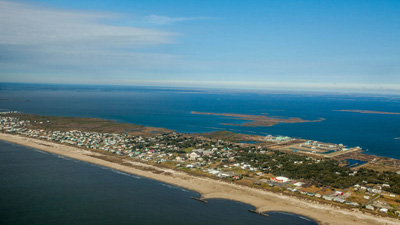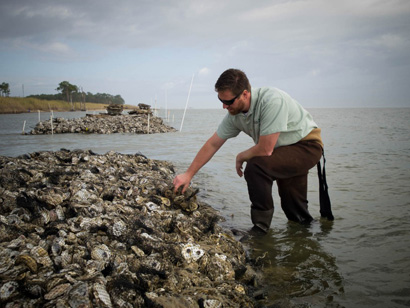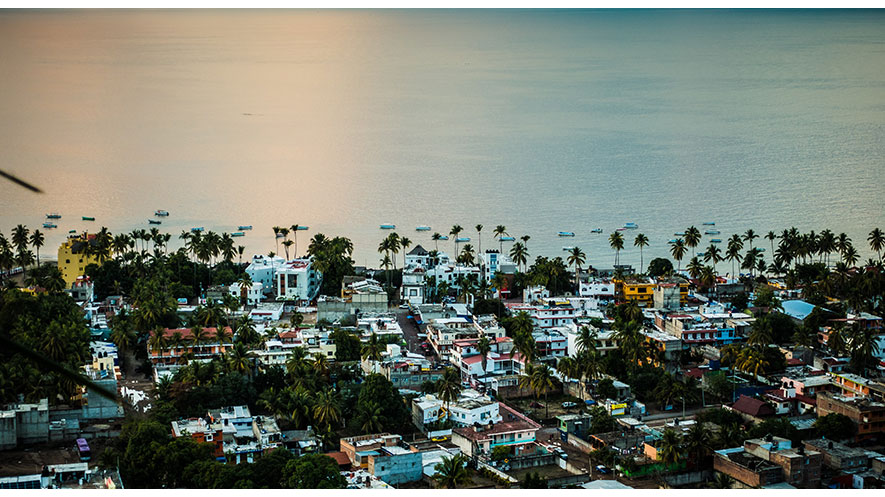New study reveals that nature-based options for coastal defense, such as marsh and oyster reef restoration, could prevent $50 billion in flood damages on the Gulf Coast
Low lying coastal regions are home to over 1 billion people worldwide. We are fortunate in that these communities often have some level of protection against the elements as reefs, mangroves and wetlands naturally buffer the impacts of coastal storms. But how effective is nature at protecting our coastline in comparison to human-made defenses?
A new study compares the cost effectiveness of nature-based and artificial solutions for flood risk reduction in the US Gulf Coast. The study found that the restoration of marshes and oyster reefs are among the most cost-effective solutions. And by restoring nature's defenses, we could avert more than $50 billion in flood damages over a 20-year period.
 Grand Isle is a barrier island located in the Gulf of Mexico at the mouth of Barataria Bay in Louisiana. Restoration of oyster reef habitat along the Grand Isle shoreline is intended to reduce erosion of coastal marshes and protect communities from storm surge. (Photo by Erika Nortemann/The Nature Conservancy)
Grand Isle is a barrier island located in the Gulf of Mexico at the mouth of Barataria Bay in Louisiana. Restoration of oyster reef habitat along the Grand Isle shoreline is intended to reduce erosion of coastal marshes and protect communities from storm surge. (Photo by Erika Nortemann/The Nature Conservancy)
Flooding along the Gulf Coast has been forecasted to cost between $134 and $176 billion by 2030. The annual risk of flooding in the region is expected to more than double by 2050 as the effects of climate change, land subsidence and concentration of assets in the coast zone increase, say the authors of the study published April 11 in PLOS ONE.
By using the Economics of Climate Adaptation (ECA) approach developed by reinsurance company Swiss Re and partners, researchers at UC Santa Cruz, the Nature Conservancy, and the Swiss Federal Institute of Technology at ETH Zurich sought to understand what drives coastal risk and evaluate the cost-effectiveness of adaptation options using the Gulf of Mexico as a case study.
The study is the first to quantitatively compare the cost effectiveness of a wide suite of natural and artificial flood reduction measures across an entire region.
 Jeff DeQuattro, marine program director for the Nature Conservancy in Alabama, examines young oysters growing on artificial reefs at an oyster restoration site at Alabama Port. A new study shows restoration of marshes and oyster reefs are among the most cost-effective solutions for reducing coastal flood risks. (Photo by Andrew Kornylak)
Jeff DeQuattro, marine program director for the Nature Conservancy in Alabama, examines young oysters growing on artificial reefs at an oyster restoration site at Alabama Port. A new study shows restoration of marshes and oyster reefs are among the most cost-effective solutions for reducing coastal flood risks. (Photo by Andrew Kornylak)
Investing in our coastline’s future
Many countries are recognizing the need for improved coastal defenses as the impending threat of rising sea levels and coastal storms continue to grow. To protect coastal communities from devastating storms – such as hurricanes Irma, Maria and Harvey that struck the Gulf Coast and Caribbean in 2017 - many of the world's governments are undertaking big investments to address the flood risks of today and in the decades to come.
Researchers measured the flood risks to people and property for the entire US coast of the Gulf of Mexico under current and future climate scenarios and economic growth projections. They found that future flood risks from coastal hazards will grow, and that the major driver of risk in the Gulf is coastal development. It is particularly true for the most extreme and costly events that the more people and property exposed to coastal hazards, the greater the flooding risk. The study also found that climate change will result in more frequent losses and projected that events causing $100 billion in damages may become around three times more frequent in the future.
Between 2015 and 2021, the UK is investing £2.6 billion in a scheme to advance flooding and coastal erosion risk management. Significant investment in hazard mitigation is also underway in the US such as at the Federal Emergency Management Agency (FEMA). While state and federal agencies are investing in coastal protection strategies to reduce these risks, most of the funds are going toward so-called "grey infrastructure" such as seawalls, which the study authors say can further degrade coastal ecosystems. The researchers also found that while many artificial solutions such as levees and home elevation are highly effective, they are also expensive to implement at scale.
“The need for adaptation is increasing, and the cost of inaction is too high”
Looking to nature
In the Gulf of Mexico, oyster reefs, coastal wetlands, barrier islands, and beach dunes provide coastal protection by dissipating wave energy, trapping sediments, and attenuating storm surge. These nature-based approaches can be directly compared with artificial, "grey" measures in a common framework using open-source tools based on those used by the insurance industry. Using this framework, the study found that for the Gulf Coast, oyster reef and marsh restoration are among the most cost-effective solutions for flood risk reduction. These nature-based solutions can be even more cost effective if additional ecosystem services such as fisheries, recreation, and other benefits are considered.
“We show that nature-based measures for flood reduction can be considered right alongside artificial or ‘grey’ measures such as seawalls in industry-based benefit-cost models. This removes a major impediment for engineers, insurers, and risk management agencies for building coastal resilience more naturally,” said project team leader Michael Beck, lead marine scientist at the Nature Conservancy and a research professor at UC Santa Cruz.
Nature-based solutions are already emerging as a preferred approach to flood defense in many parts of Europe. The European Union’s Biodiversity Strategy called for nature-based approaches to reduce biodiversity loss by urging the development of green infrastructure. This was followed by an EU Research and Innovation policy agenda for Horizon 2020 on Nature-Based Solutions and Re-Naturing Cities with the aim to ‘greening the economy and achieving sustainable development’ across the European Union. The study authors noted that there are also increasing calls for the development of resilient infrastructure in the US as well as increasing efforts to help coastal managers better develop beach nourishment projects and new innovative approaches for improving flood risk modeling.
By comparing cost-effectiveness of a number of adaptation options, the researchers suggest that the right combination of green, grey and policy measures could avert future damages up to 42.8–57.2% of total climate risk ($57.4–101 billion in damages) over the next 20 years.
“The need for adaptation is increasing, and the cost of inaction is too high,” said lead author Borja Reguero, a coastal engineer at UC Santa Cruz. “Our ‘adaptation gap’ requires innovative approaches and targeted research to inform our investments in protection and risk management, and to balance the goals of development, conservation, and public safety.”





